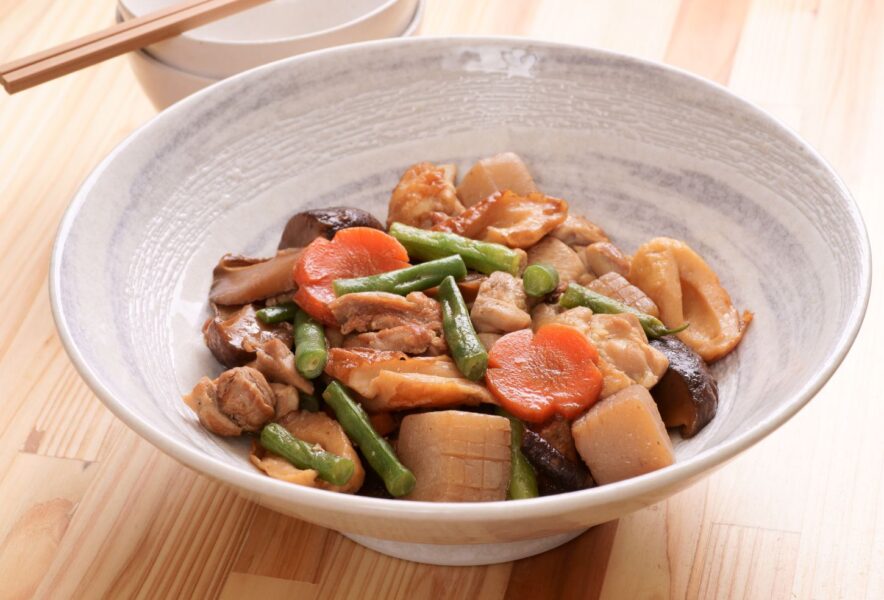Nimono, a staple of Japanese cuisine, offers a comforting and delicate way to enjoy a variety of ingredients, all simmered slowly in a rich, umami-packed broth. From vegetables to meats and fish, nimono dishes capture the essence of simplicity and balance, making them a must-try for anyone visiting Tokyo.
What is Nimono?
At its heart, nimono (煮物) refers to a variety of Japanese dishes where ingredients are simmered in a broth. The broth is usually made from dashi (a stock derived from kombu seaweed and bonito flakes), combined with soy sauce, mirin, and sometimes sake or sugar. Nimono is about bringing out the natural flavors of the ingredients by cooking them gently, allowing the taste to seep into the vegetables, meats, or fish used.
Key Ingredients of Nimono
- Dashi: The foundation of most nimono dishes, dashi is made from kelp (kombu) and dried bonito flakes (katsuobushi), providing a savory umami base.
- Soy Sauce: Adds saltiness and enhances the umami flavor.
- Mirin: A sweet rice wine that provides a slight sweetness and helps balance out the salty components.
- Sake: Used in some recipes to add depth and to soften any strong flavors from meat or fish.
These simple ingredients, when combined with seasonal vegetables, seafood, or meat, create a nuanced yet balanced flavor profile that highlights the natural tastes of each element.
Popular Varieties of Nimono
One of the beauties of nimono is its versatility, with many regional variations and ingredient combinations. Here are a few popular types you’ll find across Tokyo:
- Chikuzen-ni: A classic dish made with root vegetables like lotus root, burdock, carrots, and chicken. It’s simmered in a slightly sweet broth that enhances the earthy flavors of the vegetables.
- Nikujaga: This beloved home-cooked dish combines beef and potatoes simmered in soy sauce and mirin. Often called “Japanese comfort food,” it has a sweet, savory profile that brings warmth and nostalgia to many Japanese families.
- Kabocha no Nimono: Japanese pumpkin (kabocha) is simmered in a sweet dashi broth until tender. The natural sweetness of the pumpkin melds beautifully with the savory broth, making it a perfect side dish.
- Sakana no Nitsuke: Fish, such as mackerel or flounder, is simmered in a soy-based broth until it absorbs the flavors. This dish highlights the freshness of the seafood while balancing sweet and savory elements.
How to Enjoy Nimono
Nimono is not only a comforting dish but also one that pairs beautifully with other staples of Japanese cuisine. Whether served as part of a larger meal or as a main dish, it’s often enjoyed alongside steamed rice, miso soup, and pickled vegetables. Due to the gentle cooking method, nimono retains much of the nutritional value of the vegetables and proteins, making it a healthy and balanced option. It’s also a dish that improves with time—the longer the ingredients sit in the broth, the deeper the flavors become, so it’s great for leftovers!
Where to Find Nimono in Tokyo
In Tokyo, you can find nimono in a variety of settings, from humble izakayas (Japanese pubs) to high-end kaiseki (multi-course meal) restaurants. Here are some top spots to experience nimono:
- Izakayas: Casual izakayas offer nimono as one of their standard dishes. They’re a great place to try simple versions like nikujaga or gobo no nimono (burdock root simmered in broth).
- Kappo Restaurants: These refined eateries focus on traditional Japanese cooking techniques, and you’re likely to find nimono as part of a multi-course meal. The attention to detail and seasonal ingredients at these places make for a special dining experience.
- Department Store Food Halls: In Tokyo, food halls or depachika (basement food markets) often sell pre-made nimono dishes. It’s a convenient way to sample these dishes if you’re looking for a quick and affordable meal.
- Home-Style Restaurants: Known as shokudo or teishoku-ya, these restaurants serve traditional Japanese set meals (teishoku), where nimono is often featured as one of the side dishes.
Final Thoughts
Whether you’re after the hearty warmth of nikujaga or the light, balanced flavors of chikuzen-ni, nimono offers a taste of traditional Japanese home cooking at its finest. It’s a dish steeped in history, showcasing the beauty of seasonal ingredients and the Japanese philosophy of simple, balanced flavors.
In Tokyo, nimono can be found everywhere, from street-side izakayas to high-end restaurants. Take the opportunity to experience it for yourself and savor the comforting flavors of this timeless dish.

Comment